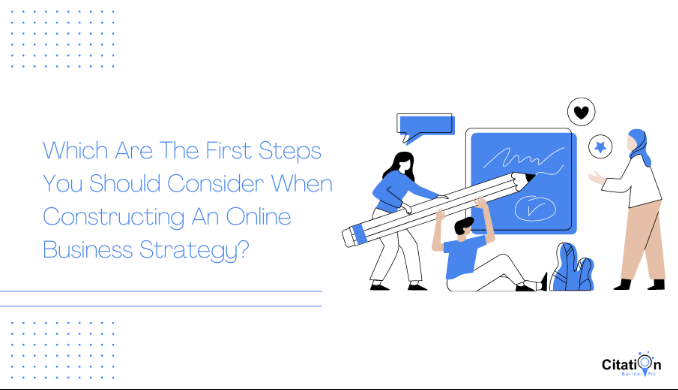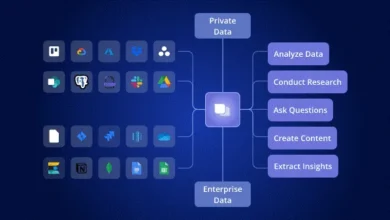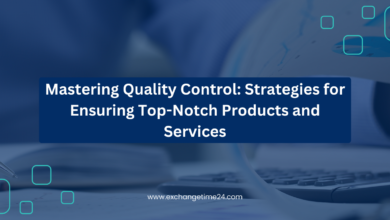What are the First Steps for Crafting Your Online Business Plan?

Identify your target audience and define clear business goals. Conduct a thorough market analysis to inform your strategy.
Constructing an online business strategy starts with understanding who you will serve and what you aim to achieve. A successful strategy hinges on a thorough knowledge of your target market, encompassing their needs, preferences, and behaviours. Your business goals must be well-defined and SMART (Specific, measurable, achievable, relevant, and time-bound) and serve as the north star for all strategic decisions.
A comprehensive market analysis allows you to position your business effectively, identify opportunities for differentiation, and forecast potential challenges. This foundational step paves the way for informed decision-making, guiding the development of your marketing plan, product development, and overall business model. With these elements in place, you set a solid groundwork for an online strategy that aligns with audience expectations and drives business growth.

Contents
- 1 The Bedrock Of Online Business Success
- 2 Clear Articulation Of Your Business Goals
- 3 Market Analysis Essentials
- 4 Mapping Out Your Monetization Model
- 5 Designing An Operational Plan
- 6 Marketing Your E-commerce Platform
- 7 Financial Forethought For Online Businesses
- 8 Legal Compliance And Protection
- 9 Conclusion
The Bedrock Of Online Business Success
Starting an online venture is thrilling. Success does not come by chance. It requires a solid plan, which serves as the foundation for a thriving online business. Vital initial steps are crucial in this digital journey. Let’s dive into these foundational pillars.
Identifying Your Niche
Finding your niche is like choosing where to build your house. A strong niche ensures stability. It guides all future decisions. Follow these steps to identify your niche:
- Research the market trends and demands.
- Know your interests and passions.
- Identify gaps in the current market.
- Consider the competition in potential niches.
- Decide on a niche that aligns with your skills and market needs.
Validating Your Business Idea
You have found a niche. Now, it’s time to test whether your idea will succeed. Validation avoids costly mistakes.
Use these methods:
- Launch a mini version of your product or service.
- Gather feedback from early users.
- Test the market through pre-orders or crowdfunding.
- Create surveys and focus groups.
- Analyze data to make informed decisions.
| Validation Method | Description | Benefit |
| Lean Launch | Launching a simplified version | Minimize risk |
| Customer Feedback | Collecting opinions | Improve offering |
| Pre-sales | Selling before full launch | Assess demand |
Remember, validating shapes your strategy. It sets a clear path for growth.
Clear Articulation Of Your Business Goals
Every successful online business starts with well-defined goals. It is knowing what you aim for guides your efforts and resources. This clarity helps prioritize tasks and measure success. Let’s break down the goal-setting process into manageable steps.
Defining Short-term Objectives
Short-term objectives are your immediate focus. These are your stepping stones to more significant achievements.
- Increase website traffic by 20% in the next three months.
- Grow email subscribers to 5,000 within six months.
- Launch a new product line by the end of the quarter.
Setting Long-term Milestones
Think about where you see your business in the future. Set significant, impactful goals to strive towards.
- Achieve a market share of 10% in 2 years.
- Open up two new storefront locations by year 5.
- Hit the $1 million revenue mark within four years.
Market Analysis Essentials
Digging deep into market fundamentals is your blueprint for online success. These essentials guide us through understanding audiences and analyzing competitors. Let’s uncover these layers to map out your business plan.
Understanding Your Audience
Who will buy your product? Knowing this shapes everything you do. You must identify who needs your product and why. Create profiles for different users. Consider age, location, gender, interests, and spending habits. Use surveys, social media, and online tools for insights. This knowledge becomes the foundation of your strategy.
- Age & Demographics: Tailor your language and product to fit these groups.
- Interests: Know what excites your audience to engage them better.
- Spending Habits: Price products within their budget.
Analyzing Competitor Strategies
Sift through your competitors’ online presence. Learn from their hits and misses. Analyze their website, SEO practices, content, and customer engagement. Check their social media for user interactions. This intel guides your approach.
| Aspect | What to Look For |
| Website Design | User experience and layout |
| Content | Quality, relevance, and frequency |
| SEO | Keywords, rankings, and backlinks |
| Social Media | Engagements, campaigns, and followers |
Mapping Out Your Monetization Model
Mapping out your monetization model is crucial when launching an online business. It’s your plan for generating income. With a transparent model, even the most innovative businesses can succeed. Let’s dive into choosing a revenue stream and effective pricing strategies.
Choosing A Revenue Stream
Your choice of revenue stream defines your business’s financial future. Here are the standard options:
- Product Sales: Sell physical or digital goods directly to the customer.
- Service Offerings: Provide valuable services and charge accordingly.
- Subscription Models: Charge a recurring fee for ongoing access to a product or service.
- Affiliate Marketing: Earn commissions by promoting other businesses’ products.
- Advertising: Monetize your website’s traffic through ads.
Pricing Strategies That Work
Pricing can make or break your business. See strategies that attract buyers and maintain profits:
| Strategy | Description | Best for |
| Cost-Plus | Add a markup to the cost of goods | Products with clear costs |
| Value-Based | Price based on perceived value | Unique or high-value items |
| Penetration | Start low to enter the market | New businesses |
| Skimming | Set high prices initially | Innovative products |
| Dynamic | Adjust prices based on demand | E-commerce platforms |
Select the right strategy that aligns with your product’s uniqueness, competition, and target market. Always test different price points to find what resonates with your customers.
Designing An Operational Plan
A well-designed operational plan lays the groundwork for success when crafting an online business strategy. It sketches out the day-to-day execution of business objectives, ensuring efficiency and scalability. Let’s delve into the essential components, starting with technological infrastructure and then supplier and inventory management.
Technological Infrastructure
Firm technological foundations anchor an online business. A robust plan encompasses:
- Website performance – Fast, reliable, and user-friendly.
- Secure hosting solutions.
- Scalable e-commerce platforms – Facilitate growth.
- Integrated payment systems – Ensure safe transactions.
- Customer relationship management (CRM) systems.
- Data analysis tools – Inform business decisions.
Together, these elements support a seamless online customer experience.
Supplier And Inventory Management
Efficient management of suppliers and inventory is vital. Key considerations include:
- Vendor selection – Partner with reliable suppliers.
- Inventory levels – Maintain balance to meet demand.
- Order fulfilment – Efficient processes save time.
- Supply chain logistics – Stay agile and adaptive.
Effective systems ensure stock availability and timely delivery, which is critical for customer satisfaction and repeat business.
Marketing Your E-commerce Platform
Constructing an online business strategy involves several key steps, and one of the most critical aspects is marketing. A comprehensive approach to digital marketing can drive traffic to your e-commerce platform, enhance brand awareness, and boost sales. Let’s delve into the initial steps you need to take to establish a robust online presence for your e-commerce site.
Exploring Digital Marketing Channels
Every e-commerce platform needs a strategy to reach potential customers. Here’s where digital marketing channels play a crucial role. Consider the following avenues:
- SEO: Optimize your website for search engines to increase visibility.
- PPC: Invest in pay-per-click ads for immediate traffic.
- Email Marketing: Send newsletters and promotions to subscribers.
- Content Marketing: Use blogs and videos to engage users.
Creating A Social Media Presence
Visibility on social media can directly influence your platform’s success. Start by:
- Selecting the right platforms for your target audience
- Creating captivating content regularly
- Engaging with followers to build a community
Remember to track and analyze your performance with social media tools. This data helps refine your strategy for better results.
Financial Forethought For Online Businesses
Starting an online business demands thorough financial planning. It’s about knowing where every dollar goes and predicting future income. A solid plan can make the difference between thriving and just surviving. Let’s dive into the crucial first steps in setting a financial foundation for your online business.
Budgeting With Precision
Budgets are blueprints for business success. They help you control spending and prioritize investments. Begin by listing expected costs. This might include:
- Web hosting and domain fees
- Design and development costs
- Marketing and advertising budgets
- Product or inventory expenses
- Software subscriptions
Always include a buffer for unexpected costs. Use tables to compare monthly projected expenses against actual spending. It helps pinpoint where to adjust funds.
Projection Of Income And Expenses
Next, assess future income against expenses. Use precise projections to ensure profitability. Consider these factors:
- Sales forecasts based on market research
- Costs of goods sold (COGS) to understand profit margins
- Operation costs for smooth business running
- Break-even analysis to identify when you’ll start making profits
Combine this with historical data, if available, to refine your projections. It’s vital for anticipating cash flow needs and avoiding shortfalls.
Legal Compliance And Protection
Starting an online business means more than just an idea and a website. It means ensuring that the business operates on the right side of the law. Attention to legal compliance and protection preserves the business’s integrity and guards against potential legal challenges.
Getting The Right Licenses
Securing proper licenses is critical for any business’s legality. Depending on the industry, these licenses signify that the business meets specific standards. This boosts consumer trust.
- Research local and industry-specific licensing requirements.
- Apply for licenses through appropriate government bodies.
- Renew licenses as needed to maintain business operations.
Terms And Privacy Policies
Transparent terms and privacy policies are paramount for online businesses. Customers value their data and want to know how businesses use and protect it.
- Create clear and comprehensive terms of service.
- Establish a privacy policy that complies with laws like GDPR or CCPA.
- Update policies regularly to reflect changes in operations or legislation.
Conclusion
Building an effective online business strategy sets the stage for success. Start by defining goals and understanding your target market. Embrace analytics and adapt as needed. Remember, a solid foundation and continuous improvement drive long-term growth and profitability. Take these initial steps and watch your online venture thrive.


